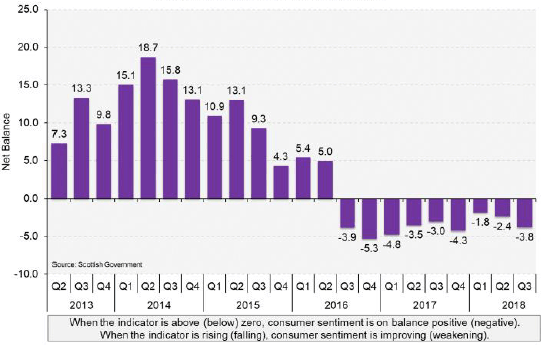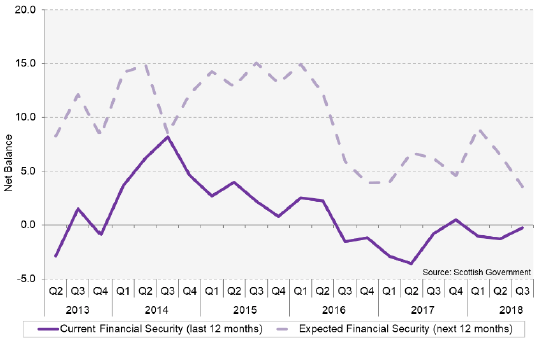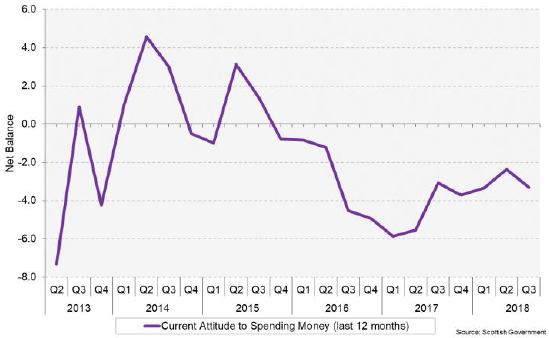State of the economy: October 2018
Report produced tri-annually by the Chief Economic Adviser to provide a picture of the Scottish economy in an international context.
This document is part of a collection
Consumer Sentiment[7]
Alongside softer business confidence in the third quarter of the year, consumer sentiment in Scotland remained weak over the quarter.
The chart shows that Consumer Sentiment has been negative since the EU referendum and has weakened over the past two quarters compared to the start of the year.
Scottish Consumer Sentiment Indicator

The table below shows the overall indicator score for Q3 2018 and a breakdown of the 5 individual indictors that make up the overall indicator.
Over the quarter, there has been a notable weakening in consumer sentiment regarding expected economic performance over the next 12 months. The indicator for Scotland was -15.2 in Q3 2018 - its lowest level since the series began - implying that the balance of respondents expect economic performance to be weaker in 12 months’ time.
| Scottish Consumer Sentiment | Latest Score (Q3 2018) | Previous Score (Q2 2018) | Change compared to the previous quarter |
|---|---|---|---|
| Overall Indicator Score | -3.8 | -2.4 | -1.4 |
| Economy performance - last 12 months | -3.8 | -4.0 | 0.2 |
| Economy performance - next 12 months | -15.2 | -10.8 | -4.4 |
| Household financial security - last 12 months | -0.3 | -1.3 | 1.0 |
| Household financial security - next 12 months | 3.6 | 6.5 | -2.9 |
| Attitude to household spending - current | -3.3 | -2.4 | -0.9 |
The table also shows household current and future financial security and attitudes to spending. It shows that over the past 12 months, sentiment regarding household financial security has been weak, although expectations are that household financial security will, on balance, improve over the next 12 months (albeit less so than in the previous quarter). This positive sentiment is not reflected in how relaxed households currently are about spending money, which remains negative and has weakened over the quarter. The Box below provides further analysis on the household financial security aspects of the Scottish Consumer Sentiment results, focusing on the longer trends.
Trends in Consumer Sentiment: Household Finances and Spending Indicators
The consumer sentiment indicators on household finances and spending provide some insight into what might happen to household consumption – which accounts for approximately 65% of Scottish GDP. With uncertainty over the economic outlook and with the household savings ratio close to historic lows at 3.1%, a fall in consumption is possible if consumers reduce or defer spending, particularly on luxury and big ticket items.
The adjacent chart shows that in the third quarter of 2018, the indicator on financial security over the last 12 months remained weak and on balance close to zero. The indicator on financial security over the next 12 months fell and is at its lowest level in the time series.
Household Finances Indicators

The indicator on current attitudes to spending money remained weak and the long run trend has generally been negative.
While, on balance, respondents feel relatively more positive in their expectations about their household finances than they do regarding the Scottish economy, the scores on both indicators fell to their lowest levels since the series began.
The results only reflect sentiment and don’t confirm that households will change their consumption behaviour in practice. However, they do present the risk of weakening expectations about the Scottish economy and household financial security coupled with a weakness in the attitude to spending money.
Household Spending Indicator

This can be a rational decision for a given household, however, in aggregate terms it could have a negative impact on aggregate consumption growth with wider knock-on impacts on the labour market and investment decisions.
Contact
There is a problem
Thanks for your feedback